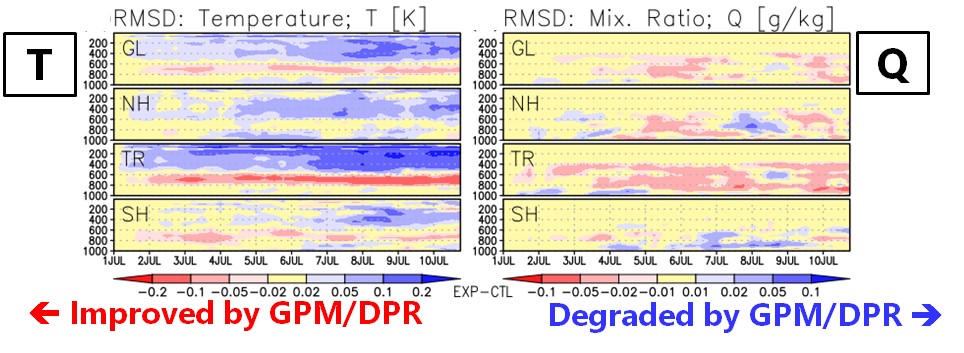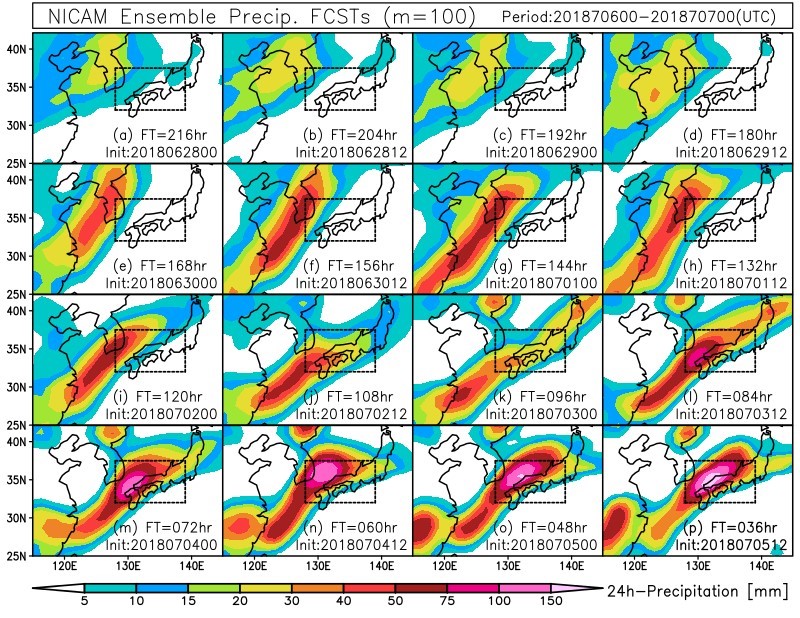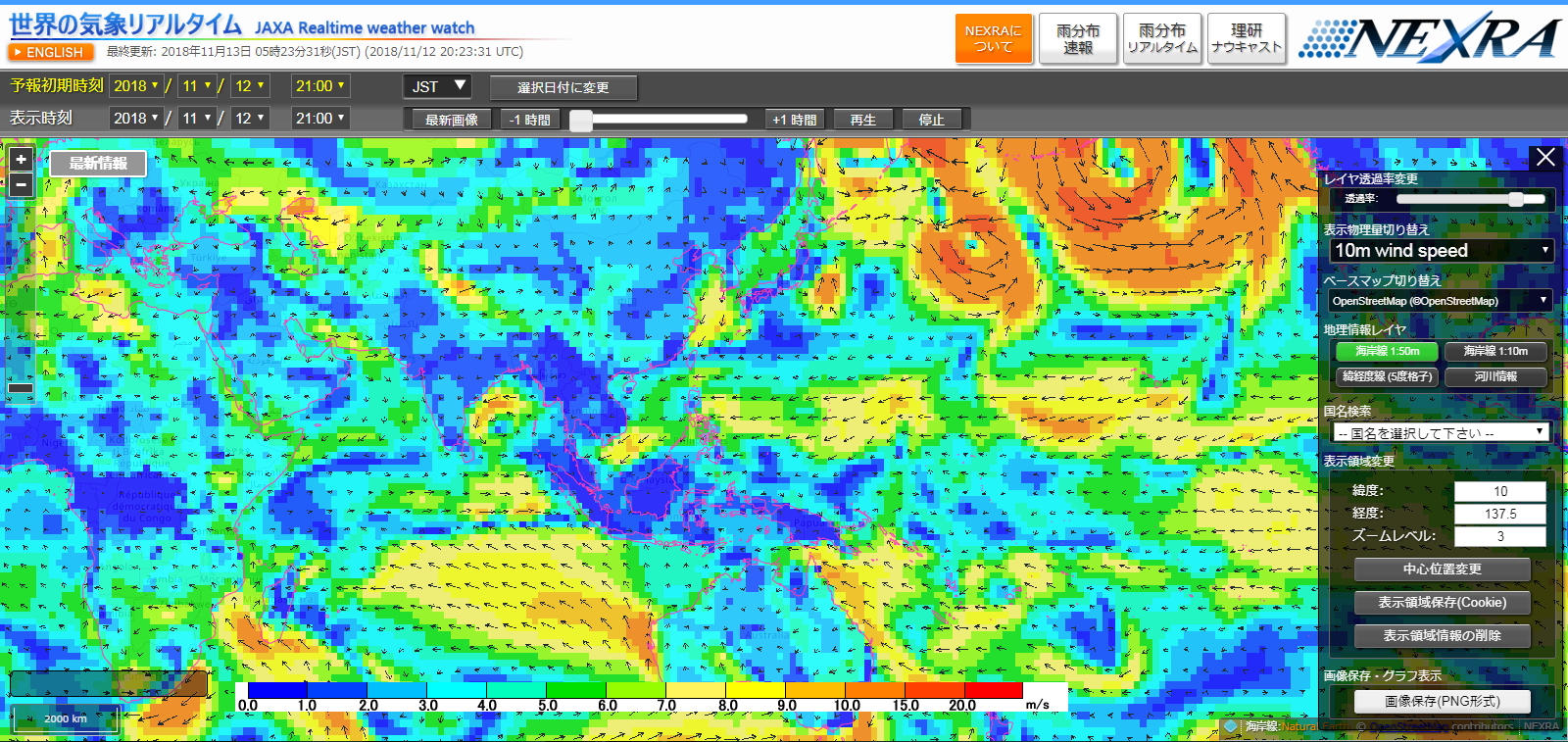Research for data assimilation of satellite global rainfall map
JAXA Supercomputer System Annual Report April 2018-March 2019
Report Number: R18ER0201
Subject Category: Space Technology
- Responsible Representative: Naoto Matsuura, Director, Space technology Directorate I, Earth Observation Research Center
- Contact Information: Space technology Directorate I, Earth Observation Research Center, Takuji Kubota(kubota.takuji@jaxa.jp)
- Members: Koji Terasaki, Shunji Kotsuki, Kaya Kanemaru, Kenta Kurosawa, Ying-Wen Chen, Takemasa Miyoshi, Masaki Satoh, Takuji Kubota
Abstract
This study explores an effective use of satellite data including GSMaP and GPM/DPR through an advanced ensemble data assimilation method for improving numerical weather prediction (NWP) and pioneering a new precipitation product based on an NWP model and satellite observations, named as NICAM-LETKF JAXA Research Analysis (NEXRA).
Reference URL
Please refer to ‘JAXA Realtime weather watch‘.
Reasons for using JSS2
In this study, the JSS2 is used for the NICAM-LETKF experiments to assimilate satellite observations and to conduct NWP model forecasts. The JSS2 is a necessary infrastructure for our study to conduct massive computations for the ensemble-based data assimilation and ensemble atmospheric simulations.
Achievements of the Year
(1) Assimilating GPM/DPR reflectivity into NICAM-LETKF
In this year, we performed the data cycle (DA) experiment assimilating GPM/DPR using the NICAM-LETKF; however, we did not improve atmospheric states significantly. While humidity fields were improved by DA, temperature fields were degraded. We are now planning to use the GPM/DPR observation for estimating NICAM’s model parameter(s) through DA.
(2) Predictability of Record-Breaking Rainfall in Japan in July 2018 (RJJ18)
Recently, a 100-member near-real-time NICAM-LETKF system started running on JAXA’s second-generation supercomputer system (JSS2) as NICAM-LETKF at JAXA Research Analysis (NEXRA). We investigated the predictability of RJJ18 using the NEXRA system. We demonstrated that intense precipitation in western Japan on July 6 had been well predicted 3 days in advance by the NEXRA (Fig. 2).
(3) Developments of the NICAM -LETKF system
The near-real-time system of NICAM-LETKF on JSS2 is named as NICAM-LETKF JAXA research analysis (NEXRA). The NEXRA system runs stably over two years. The recent NEXRA data have been visualized and checked on a web page ( https://www.eorc.jaxa.jp/theme/NEXRA/index_e.htm ) (Fig. 3).
(4) Ensemble forecast experiments with a higher mesh of NICAM
Ensemble simulations are conducted to explore predictability of an extreme event by using the NEXRA data. We tried to simulate the heavy rain event in July 2018 at western Japan. From results of the 100-member ensemble simulations with 14-km mesh, some simulations successfully predict spatial pattern of the heavy rain (Fig. 4). This result was disclosed on a web page ( https://www.eorc.jaxa.jp/earthview/2018/tp181114.html ).

Fig.1: Change in root mean square differences (RMSD) due to the GPM/DPR assimilation for (left) temperature (K), and (right) water vapor mixing ratio (g/kg) relative to the ERA-Interim reanalysis. Warm and cold colors represent improvement and degradation due to the DA. The vertical and horizontal axes show the pressure level (hPa) and date/month in July 2014. Spatially-averaged RMSDs are shown for global (GL), Northern Hemisphere (NH), Tropics (TR), and Southern Hemisphere (SH), respectively.

Fig.2: Ensemble-mean precipitation (mm), accumulated over 0000-2400 UTC 6 July 2018, for 16 forecasts initialized every 12 h from (a) 0000 UTC 28 June to (p) 1200 UTC 5 July 2018. Adopted from Kotsuki et al. (2019).

Fig.3: A visualized page of the NEXRA data on web site ”JAXA Realtime weather watch” ( https://www.eorc.jaxa.jp/theme/NEXRA/index_e.htm )

Fig.4: Spatial pattern of 24-h averaged rain [mm/hr] in 6th July [mm/hr], 2018. a) Ground observation. b) The best member (member 73) with a 14-km mesh simulation, c) the 100-member ensemble mean with 14 km mesh. The initial date of simulations is at 00UTC, 5th July, 2018.
Publications
– Peer-reviewed papers
(1) Kotsuki, S., Terasaki, K., Yashiro, H., Tomita, H., Satoh, M., & Miyoshi, T. (2018): Online model parameter estimation with ensemble data assimilation in the real global atmosphere: A case with the Nonhydrostatic Icosahedral Atmospheric Model (NICAM) and the Global Satellite Mapping of Precipitation data. Journal of Geophysical Research: Atmospheres, 123, 7375-7392. doi:10.1029/2017JD028092
(2) Kotsuki S., Terasaki K., Kanemaru K., Satoh M., Kubota T. & Miyoshi T. (2019): Predictability of Record-Breaking Rainfall in Japan in July 2018: Ensemble Forecast Experiments with the Near-real-time Global Atmospheric Data Assimilation System NEXRA. SOLA, Volume 15A Pages 1-7. doi:10.2151/sola.15A-001
(3) Terasaki, Koji & Kotsuki, Shunji & Miyoshi, Takemasa (2019): Multi-year analysis using the NICAM-LETKF data assimilation system. SOLA. Volume 15 Pages 41-46. doi:10.2151/sola.2019-009.
– Invited Presentations
(1) 2018/5/20 Terasaki, K., T. Miyoshi, Accounting for the observation error correlation in data assimilation, JpGU2018, Makuhari (poster)
(2) 2018/6/4 Takemasa MIYOSHI, Shunji KOTSUKI, Koji TERASAKI, Keiichi KONDO, Guo-Yuan LIEN, Kenta KUROSAWA, Masaki SATOH, Hirofumi TOMITA, and Eugenia KALNAY, Enhancing Data Assimilation of GPM Observations, AOGS, Honolulu, Hawaii
(3) 2018/10/5 T. Miyoshi, Satellite data assimilation and parameter estimation with NICAM-LETKF, CEN/CliSAP WORKSHOP Climate Data Assimilation, Hamburg, Germany
(4) 2018/10/11 T. Miyoshi, Data assimilation for nonlinear ensemble forecasts, Fourth meeting of the WWRP PDEF Working Group, Tokyo
(5) 2019/1/25 T. Miyoshi, Enhancing Data Assimilation of GPM Observations, The Joint PI Meeting of JAXA Earth Observation Missions FY2018, TOKYO
– Oral Presentations
(1) 2018/4/9 Takemasa Miyoshi, Shunji Kotsuki, Koji Terasaki, Keiichi Kondo, Guo-Yuan Lien, Kenta Kurosawa, Masaki Satoh, Hirofumi Tomita, and Eugenia Kalnay, Enhancing data assimilation of GPM observations, EGU, Vienna, Austria2018/4/26
(2) 2018/5/7 Kotsuki S., Kurosawa K., and Miyoshi T., Ensemble Forecast Sensitivity to Observations Verified with Multiple References, The 8th EnKF Data Assimilation Workshop, Montreal, Canada
(3) 2018/11/15 Kotsuki S., Sato Y., Terasaki K., Yashiro H., Tomita H., Satoh M. and Miyoshi T., Model Parameter Estimation with Data Assimilation using NICAM-LETKF, 5th International Workshop on Nonhydrostatic Models, Tokyo
(4) 2018/12/17 Takemasa Miyoshi, Enhancing Data Assimilation of GPM Observations, NICAM-LETKF and Satellite DA Mtg, Kobe
(5) 2019/1/22 Kotsuki S., Sato Y., Terasaki K., Yashiro H., Tomita H., Satoh M. and Miyoshi T., Model Parameter Estimation with Data Assimilation using NICAM-LETKF, 7th International Symposium on Data Assimilation, Kobe
(6) 2018/5/22 Kaya Kanemaru and Masaki Satoh, Satellite and Model Analysis of Short-Term Characteristics Related with Convective Activity over Tropical Oceans, AS46-D3-PM1-P-017, AOGS 2018, Hawaii, June, 2018
– Poster Presentations
(1) 2018/5/9 Kotsuki S., Terasaki K., and Miyoshi T., Ensemble-Based Data Assimilation of GPM/DPR Reflectivity into the Nonhydrostatic Icosahedral Atmospheric Model NICAM, The 8th EnKF Data Assimilation Workshop, Quebec, Canada
(2) 2018/11/14 Koji Terasaki, Takemasa Miyoshi, Data assimilation and forecast experiments for the record-breaking rainfall event in Japan in July 2018 with NICAM-LETKF at 112-km and 28-km resolution, 5th International Workshop on Nonhydrostatic Models (NHM2018), Tokyo
(3) 2019/1/21 Koji Terasaki, Shunji Kotsuki, Takemasa Miyoshi, Accounting for the horizontal observation error correlation of precipitation observation, 7th International Symposium on Data Assimilation (ISDA2019), Kobe
(4) 2019/1/22 Kotsuki S., Ota Y., and Miyoshi T., Adaptive covariance relaxation methods for ensemble data assimilation based on innovation statistics, 7th International Symposium on Data Assimilation, Kobe
(5) 2019/1/22 Kotsuki S., Terasaki K., and Miyoshi T., Ensemble-Based Data Assimilation of GPM/DPR Reflectivity into the Nonhydrostatic Icosahedral Atmospheric Model NICAM, 7th International Symposium on Data Assimilation, Kobe
(6) 2019/1/22 Kotsuki S., Kurosawa K., and Miyoshi T., Properties on Ensemble Forecast Sensitivity to Observations, 7th International Symposium on Data Assimilation, Kobe
(7) 2019/2/18 Kotsuki S., Sato Y., Terasaki K., Yashiro H., Tomita H., Satoh M. and Miyoshi T., Model Parameter Estimation with Data Assimilation using NICAM-LETKF, The 1st R-CCS International Symposium, Kobe
(8) 2019/2/18 Koji Terasaki, Takemasa Miyoshi, Data assimilation and forecast experiments for the record-breaking rainfall event in Japan in July 2018 with NICAM-LETKF at 112-km and 28-km resolution, The 1st R-CCS International Symposium, Kobe
(9) 2018/5 Kaya Kanemaru and Masaki Satoh: Satellite and model analysis of short-term precipitation characteristics over tropical oceans, AAS04-11, Japan Geoscience Union Meeting 2018, Chiba, May 2018
(10) 2018/6/6 Kaya Kanemaru and Masaki Satoh: Satellite and model analysis of short-term precipitation characteristics over tropical oceans, AAS04-11, Japan Geoscience Union Meeting 2018, Chiba, May 2018
(11) 2018/10 Kaya Kanemaru, Masaki Satoh, Koji Terasaki, Shunji Totsuki, Takemasa Miyoshi, and Takuji Kubota: 3.5km Mesh Ensemble Simulations by NICAM-LETKF Assimilating GSMaP, 2018 PMM Science Team Meeting, Phoenix , October 2018
– Web
http://www.data-assimilation.riken.jp/nicam-letkf/achievements_nl.html
Usage of JSS2
Computational Information
- Process Parallelization Methods: MPI
- Thread Parallelization Methods: OpenMP
- Number of Processes: 5 – 400
- Elapsed Time per Case: 12 Hour(s)
Resources Used
Fraction of Usage in Total Resources*1(%): 5.80
Details
Please refer to System Configuration of JSS2 for the system configuration and major specifications of JSS2.
| System Name | Amount of Core Time(core x hours) | Fraction of Usage*2(%) |
|---|---|---|
| SORA-MA | 50,190,065.49 | 6.14 |
| SORA-PP | 17,050.09 | 0.14 |
| SORA-LM | 0.00 | 0.00 |
| SORA-TPP | 0.00 | 0.00 |
| File System Name | Storage Assigned(GiB) | Fraction of Usage*2(%) |
|---|---|---|
| /home | 1,935.96 | 2.00 |
| /data | 684,166.27 | 12.07 |
| /ltmp | 13,671.88 | 1.17 |
| Archiver Name | Storage Used(TiB) | Fraction of Usage*2(%) |
|---|---|---|
| J-SPACE | 19.88 | 0.70 |
*1: Fraction of Usage in Total Resources: Weighted average of three resource types (Computing, File System, and Archiver).
*2: Fraction of Usage:Percentage of usage relative to each resource used in one year.
JAXA Supercomputer System Annual Report April 2018-March 2019


